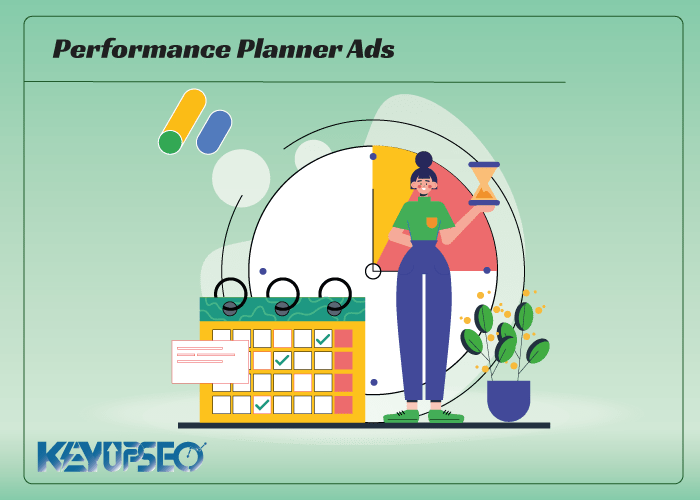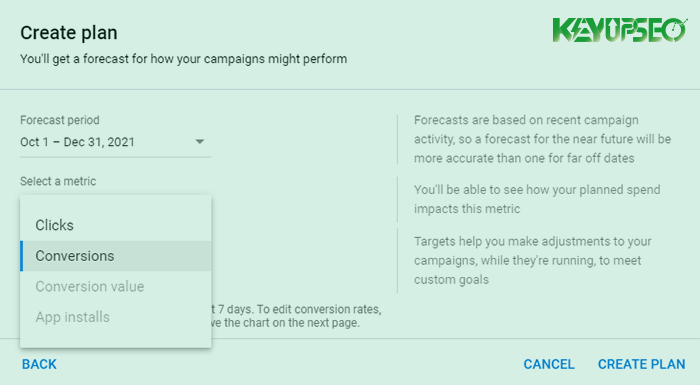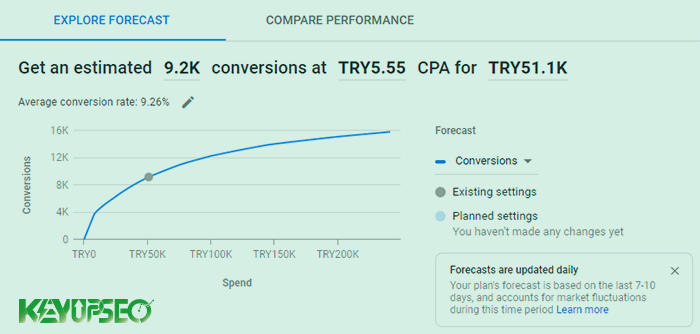
Increasing conversion with Performance Planner in Google Ads
The Performance Planner tool, which was recently added to Google Ads, helps you to improve the performance of Google Ads advertising campaigns.
Plan to improve the efficiency of your ads with the Performance Planner tool, so that you get the most return on the investment you have made for Google Ads.
Planning is the first critical step in achieving success with Google Ads.
Digital marketing is constantly expanding to help businesses like yours connect with more customers.
With advanced planning for your monthly budget in Google Ads, you can ensure that your ads are in front of people when they need your products or services to get the most conversions and hit your key performance indicators (KPIs).
Advantage of using Performance Planner
With advanced advertising budget planning, you will achieve effective results in your campaigns.
Some of these are:
- Predict the potential of spending your current Google Ads campaign budget for the future, to make better decisions for setting and changing campaign budgets.
- Take advantage of seasonal opportunities to increase your income.
- Determine the scope and budget of your new campaigns in such a way that you get the highest ROI.
- Find new opportunities to increase your sales volume through Google Ads.
Performance Planner is the newest Google Ads tool that helps you determine the advertising budget needed to reach your marketing goals.
What is Performance Planner in Google Ads, and how does it work?
Performance Planner is a new statistical forecasting tool in Google Ads that helps you review your monthly, quarterly, and annual campaign budgets and improve your ROI.
This tool suggests the optimal bid and average daily budget for your campaigns so that you can get more conversions in the future.
If you don't make any changes to the campaigns you're currently running, Performance Planner predicts what you can achieve in the future. This prediction is shown with a gray dot.
How does Performance Planner predict the effectiveness of campaigns?
Billions of searches are performed on Google every week, and these searches are the basis for increasing the accuracy of Performance Planner's predictions. Also, Google has detailed statistics of different keyword ads throughout the year, which includes click rate, advertiser's proposed cost, competitors, landing page, and keyword search rate at different times of the day.
Google Ads uses a combination of Google Ads account history and machine learning to power predictions. In Google Ads, in order to use prediction tools, your account data must exceed a certain level. (For example, to use Performance Planner for a search campaign, at least seven days must have passed since the start of your campaign and at least 3 clicks in the last week.)
How to use Performance Planner?
To start, you must create a new plan after entering the Performance Planner page. It is better not to add all advertising campaigns to one plan. Because different campaigns often have different marketing goals and the cost per conversion is different in different campaigns.

Given that forecasts are based on recent campaign information, forecasts for the near future are more accurate than forecasts for the more distant future. When creating a new plan, you must select the forecast period and the metric that you want the change to affect the cost of the campaign.
If no conversions have been created in the last week, we will not be able to create a budget forecast plan with the Conversions metric. Also, if you have run an app campaign, you can see predictions based on the number of installs.
How to forecast in Performance Planner
The following graph is related to the prediction of how the number of conversions will increase and decrease if the increase and decrease of the increase in the consumption of the campaign. The selected gray dot on the graph shows the predicted number of conversions and cost based on the current campaign settings. By clicking on any part of the blue graph, you can see the prediction of the conversion rate, the cost of each conversion and the total consumption.

Performance Planner terms of use for campaigns
- Search campaigns that use manual CPC, enhanced CPC, maximize clicks, ROAS, CPA spending strategies.
- Campaigns that have been running for at least 72 hours.
- Received at least 3 clicks in the last 7 days.
- Campaigns that have received at least one conversion (if the campaign uses conversion) in the last 7 days.
What changes does Performance Planner suggest?
When you use Performance Planner to create a plan, you will be offered one of the following suggestions:
For CPC or Enhanced CPC campaigns
Average daily budget and scale for manual campaigns (CPC) in the proposed cost (1.5 scalability means a 50% increase in the proposed cost.)
In Maximize Clicks and Maximize Conversions campaigns
An average daily budget is suggested.
In Target CPA and Target return on ad spend (ROAS) campaigns
Average daily budget and Target CPA or Target ROAS value are suggested.
It is worth considering that many unpredictable external factors can be involved in Google Ads dynamic auctions. This suggests that the planner's performance predictions may be inconsistent with what actually happens. Therefore, it is very important to continuously monitor the performance and optimize the campaigns in order to achieve the campaign goals.
You can download and view the proposed changes to achieve the anticipated goals from the Download section.
You can apply changes manually or by uploading them to Google Ads Editor.
In this article, we tried to tell an effective way to improve the performance of Google Ads advertising campaigns.
By using Keyupseo services, you can help improve the SEO process of your site and attract more users.
Release date : 3 April, 2023














